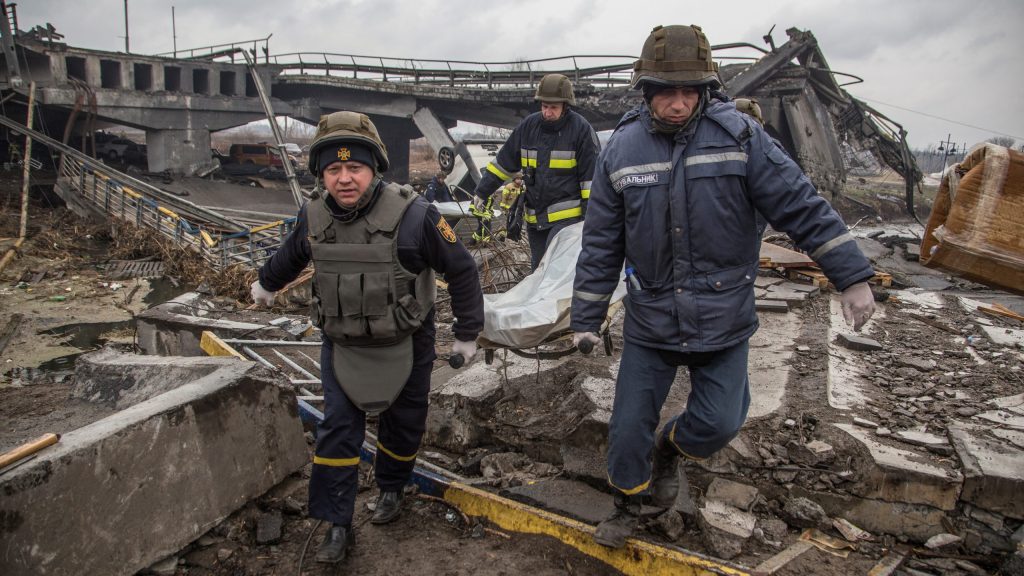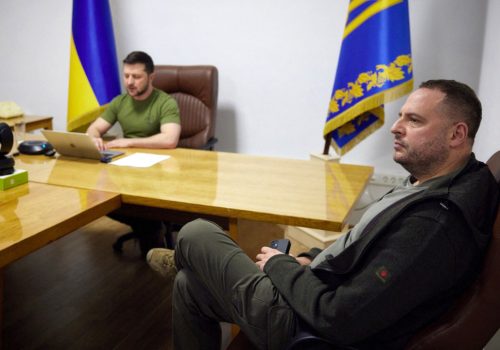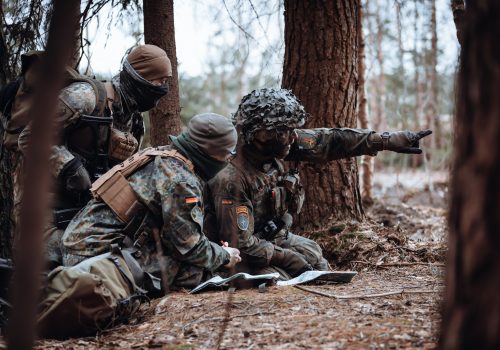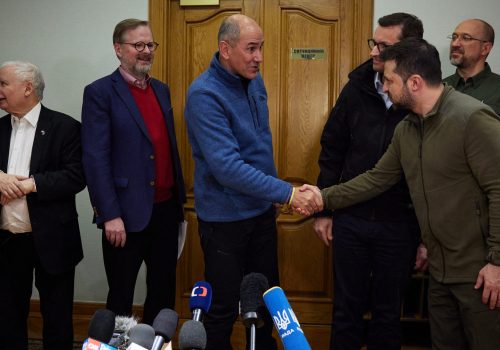Looking back, my connection to a world that no longer exists was severed on the haunting evening of April 15, 2014.
I drove with a fellow journalist—checkpoint by checkpoint—through the eerie, moonlit streets of Sloviansk, a long-neglected city in industrialized eastern Ukraine that had just fallen to Russian-backed separatists. As we headed north to the city of Kharkiv, expecting to learn more about the “anti-terror operation” the Ukrainian government had just launched against the takeover, I couldn’t stop wondering what we’d just left behind.
Now I know: It was a world in which, for a spell, peace in Europe was taken for granted.
Within weeks, war was raging. In that quiet corner of Eastern Europe, ambushes, artillery attacks, and dead civilians suddenly became a daily reality. A civilian airliner was shot out of the sky, killing 283 people of nearly a dozen nationalities. The massacre at Ilovaisk, during which a Russian invasion force gunned down hundreds of encircled Ukrainian soldiers across open fields after promising them a safe exit, exhibited a medieval brutality.
Woven through it all was an endless stream of virulent Kremlin propaganda, creating an ecosystem of lies that tore families apart and made monsters (real or imagined) out of former compatriots.
For myself and other journalists who covered the story, each escalation was another step into uncharted territory. Every new development seemed—quite literally—unbelievable. How many of us, when we first chose this profession, expected to discover what death smells like?
Over the years, as the war in Ukraine ground to an internationally acceptable slow boil, many of us returned to some semblance of normality. For their part, policymakers in Brussels and Washington also lulled themselves into a false sense of normality, doing business and attempting good-faith diplomacy with a leader who’d made a habit of invading neighboring countries.
Now, we’re watching the impossible become possible again.
In recent weeks, war crimes have unfolded around Kyiv, a major European capital to which hipsters had flown just weeks earlier for cheap cocktails and techno parties. Long a hub of culture and education, Kharkiv—with its rich architectural tapestry now shattered—has begun to evoke the same association with Russian atrocities as Aleppo or Grozny.
Maternity hospitals and nuclear plants are targets for the Russian military. Missiles have landed fifteen miles away from NATO’s borders.
And the Kremlin’s lies to justify all the killing are even more baseless and absurd than before, taking geopolitical gaslighting to an entirely new level. In Russia, a chilling effort to sell the murder of Ukrainians has morphed into a marketing campaign that is utterly macabre.
It’s time for policymakers on both sides of the Atlantic to finally understand: The world is simply a different place than it was before February 24—and nothing, at least from my experience, seems impossible anymore.
That’s why responses which once seemed unconventional, overly escalatory, or otherwise threatening to the comfortable global order must now be up for consideration. Peace in Ukraine, whenever it may come, will not mean the end of Russia’s revanchist aggression. Instead of running from this dark reality, leaders of the democratic world need to carve out a new one.
There is plenty of talk in Western capitals these days about what’s impossible; now, the focus must be on what’s possible.
In the first weeks of Russia’s invasion, the Western response did not disappoint as it did in 2014. The crippling sanctions against Russia and military support for Ukraine have been impressive. But, as Atlantic Council President Frederick Kempe suggested in a recent column, they are simply “not enough.”
Now, more than a month into this grinding war, Western momentum appears at risk of petering out. Washington’s refusal to transfer Polish combat fighters to Ukraine is only the first hint that imagination, and maybe even resolve, has its limits.
Ukrainians often interpret Western inaction as a sign that world leaders “don’t care enough” about their plight. I don’t think this is true. But I do believe officials in the United States and Europe are stuck in a box—one in which the possibilities of responding to Russian aggression are restricted by an overwhelming sense of caution, whether politically or diplomatically.
Let me be clear: Having “imagination” does not mean pursuing potentially reckless policies guided by emotion. But it does mean taking, in the words of the Council’s nonresident senior fellow Thomas Warrick, “some calculated risks to defeat Putin’s plans.” Warrick, for his part, suggests a lend-lease program between the United States and Ukraine to beef up the latter’s air defenses.
That’s just one option. In this strategic risk calculator developed by our Scowcroft Center for Strategy and Security, thirty-seven national-security experts evaluated nearly a dozen more options to help Ukraine defend itself. In short: Few of the actions worth pursuing are low-risk ventures.
Another idea proposed by nonresident fellow Irina Plaks: Fuel a brain drain from Russia by luring away its best and brightest minds—thereby starving its economy and, crucially, defense industry of advanced know-how.
But what about thinking even bigger?
When I recently spoke with another one of our experts, senior fellow Ben Judah of the Europe Center, he emphasized just how consequential the current global moment is. “This is how history works,” he told me. “Wars happen, and suddenly the world changes completely.”
He advocates one brave way to fight back against Russia: an “Atlantic pact” to decarbonize, especially by an as-yet Russian energy-dependent Europe. He also proposes another idea to prop up a deeply injured Ukraine: Wipe away its debt, which currently amounts to nearly one hundred billion dollars.
The former initiative, Judah adds, would almost certainly require a massive government-led effort to prepare households across NATO countries. He points to one recent idea, raised by American environmentalist Bill McKibben, which calls for the United States to ship heat pumps (produced under the Defense Production Act) to Europe to help wean the continent off Russian gas.
Ukrainian President Volodymyr Zelenskyy’s suggestion last month of a quick-reaction global peacemaking alliance (which he dubbed U-24, or “United for Peace”) also deserves consideration. Where he lacked detail, he compensated with a lucid understanding of the moment: “Today,” he told the US Congress, “the world does not have such tools.”
All of these efforts, in their own ways, would be unprecedented. But then again, so is Russia’s wanton decimation of a European neighbor.
Yet none of this will happen if policymakers fail to reckon with what’s already so obvious to those who have seen killing, misery, and death up close: What seems impossible today can easily become possible tomorrow.
Dan Peleschuk is the editor of New Atlanticist. He has reported widely on politics, society, and culture throughout the former Soviet Union, particularly in Russia and Ukraine.
Further reading
Fri, Mar 25, 2022
Zelenskyy’s chief of staff: Ukraine needs ‘more bravery’ from NATO
New Atlanticist By Dan Peleschuk
In this exclusive Atlantic Council event, Andriy Yermak called for more weapons, wider sanctions against Russia, and a tougher global stance against Russian President Vladimir Putin.
Tue, Mar 29, 2022
What the Baltic presidents want the West to do now against Russia
Event Recap By
Estonian President Alar Karis, Latvian President Egils Levits, and Lithuanian President Gitanas Nausėda, proposed a number of options to counter Russian aggression at an Atlantic Council Front Page event Tuesday.
Wed, Mar 30, 2022
Central Europe leads the way in backing Ukraine. Here’s its game plan for what’s next.
New Atlanticist By Petr Tůma
The European Union’s eastern members have an opportunity to prove their political and diplomatic mettle—and they're seizing it.
Image: Rescuers carry the body of a person killed amid Russia's attack on Ukraine, in Irpin, Ukraine, on March 30, 2022. Photo by Oleksandr Ratushniak/REUTERS



